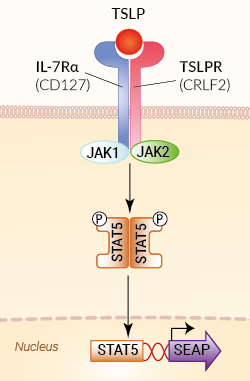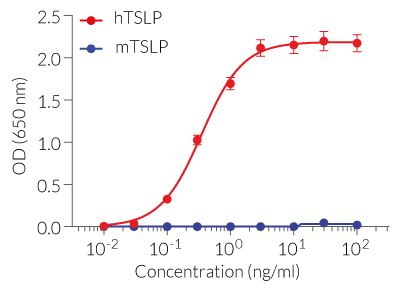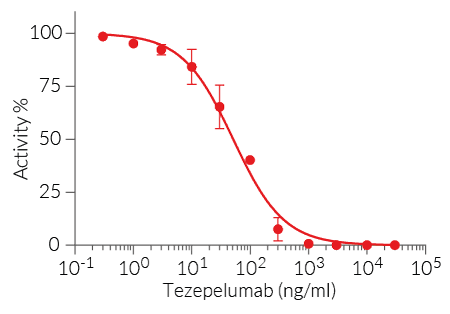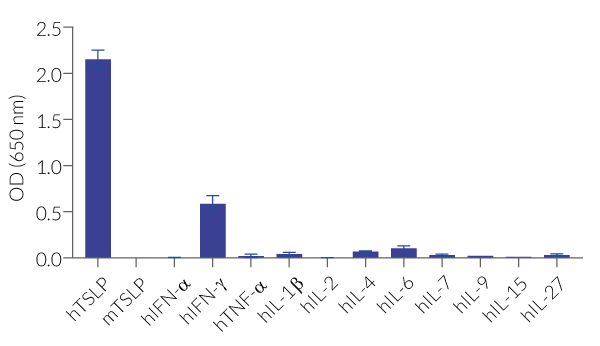TSLP Reporter HEK 293 Cells
| Product | Unit size | Cat. code | Docs. | Qty. | Price | |
|---|---|---|---|---|---|---|
|
HEK-Blue™ TSLP Cells Human TSLP Reporter Cells |
Show product |
3-7 x 10e6 cells |
hkb-tslp
|
|||
|
HEK-Blue™ TSLP vial Additional cell vial |
Show product |
3-7 x 10e6 cells |
hkb-tslp-av
|
![]() Cytokine offer: For each cytokine reporter cell line purchased, get a free vial of the matching cytokine.
Cytokine offer: For each cytokine reporter cell line purchased, get a free vial of the matching cytokine.
TSLP responsive STAT5-SEAP reporter cells

Signaling pathway in HEK-Blue™ TSLP cells
InvivoGen also offers:
HEK-Blue™ TSLP cells are designed to monitor human TSLP-induced STAT5 stimulation or inhibition. This colorimetric bioassay can be used to screen activatory or inhibitory molecules, such as engineered cytokines and neutralizing antibodies, respectively.
HEK-Blue™ TSLP cells respond specifically to recombinant human TSLP. Their reliable and consistent performance makes them suitable for release assays of activatory and inhibitory molecules such as Tezepelumab, a monoclonal antibody that targets TSLP and prevents its binding to its receptor (see figures).
Key features
- Readily assessable STAT5-SEAP reporter activity
- Convenient readout using QUANTI-Blue™ Solution
- High sensitivity to human TSLP activity
- No response to mouse TSLP
- Stability guaranteed for 20 passages
Applications
- Therapeutic development
- Drug screening
- Release assay
Thymic stromal lymphopoietin (TSLP) is a critical mediator of type 2 (T2) immune responses, acting at the early stages of inflammation. Abnormal TSLP expression is linked to immune-mediated inflammation diseases, notably asthma and allergic airway inflammation.
All InvivoGen products are for internal research use only, and not for human or veterinary use.
Back to the topSpecifications
Cell type: Epithelial
Tissue origin: Human Embryonic Kidney
Target: TSLP
Specificity: Human
Reporter gene: SEAP
Antibiotic resistance: Blasticidin, Hygromycin B, Zeocin®
Detection range: 0.1 ng/ml - 100 ng/ml (hTSLP)
Growth medium: Complete DMEM (see TDS)
Growth properties: Adherent
Mycoplasma-free: Verified using Plasmotest™
Quality control: Each lot is functionally tested and validated.
Back to the topContents
HEK-Blue™ TSLP Cells (hkb-tslp)
- 1 vial containing 3-7 x 106 cells
- 2 x 1 ml HEK-Blue™ Selection (250X concentrate)
- 1 ml Normocin® (50 mg/ml)
-
1 ml of QB reagent and 1 ml of QB buffer (sufficient to prepare 100 ml of QUANTI-Blue™ Solution, a SEAP detection reagent)
HEK-Blue™ TSLP vial (hkb-tslp-av)
- 1 vial containing 3-7 x 106 cells
![]() Shipped on dry ice (Europe, USA, Canada, and some areas in Asia)
Shipped on dry ice (Europe, USA, Canada, and some areas in Asia)
Notification: Reference #hkb-tslp-av can only be ordered together with reference #hkb-tslp.
Back to the topDetails
Thymic stromal lymphopoietin (TSLP) is a cytokine produced by epithelial and stromal cells in barrier tissues as well as innate immune cells such as dendritic cells, basophils and mast cells. It has pleiotropic actions on a wide range of immune and non-immune cell types [1]. TSLP belongs to the common γ chain (γc) cytokine family. Its receptor comprises the IL-7Rα (CD127) and TSLPR (CRLF2), a γc-like subunit. It signals through tyrosine kinases of the Janus family (JAK1 and JAK2) and signal transducer and transcription activators (STATs), notably STAT5 [1]. TSLP is a pleiotropic cytokine best known as a critical mediator of type 2 immune responses and a promoter of Th2 cell-mediated diseases (e.g. asthma) [1,2]. Emerging evidence indicates that TSLP is also implicated in viral infections, cancer, chronic inflammation and fat metabolism [1].
1. Ebina-Shibuya R. and Leonard WJ., 2023. Role of thymic stromal lymphopoietin in allergy and beyond. Nat Rev Immunol, 23(1):24-37.
2. Schmitt P. et al., 2024. TL1A is an epithelial alarmin that cooperates with IL-33 for initiation of allergic airway inflammation. J Exp Med. 221(6) e20231236.










